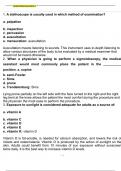Exam (elaborations)
AMCA PRACTICE EXAM 3 2024
- Course
- Institution
A stethoscope is usually used in which method of examination? a. palpation b. inspection c. percussion d. auscultation e. mensuration: auscultation Auscultation means listening to sounds. This instrument uses in-depth listening to allow various structures of the body to be evaluated by a medi...
[Show more]



